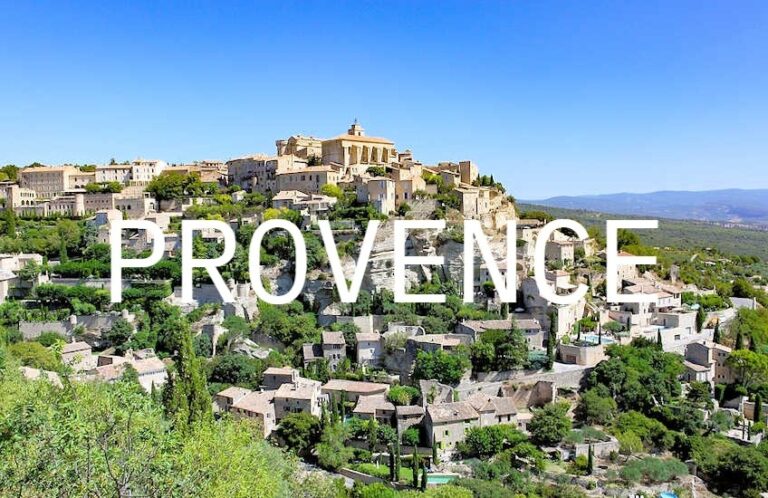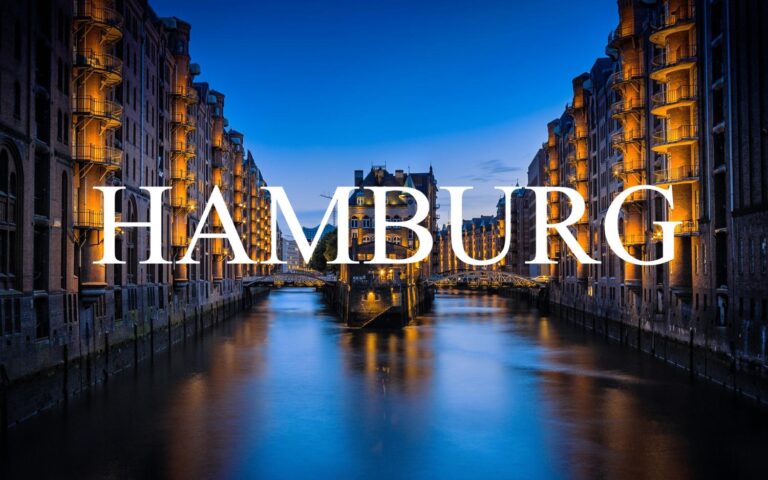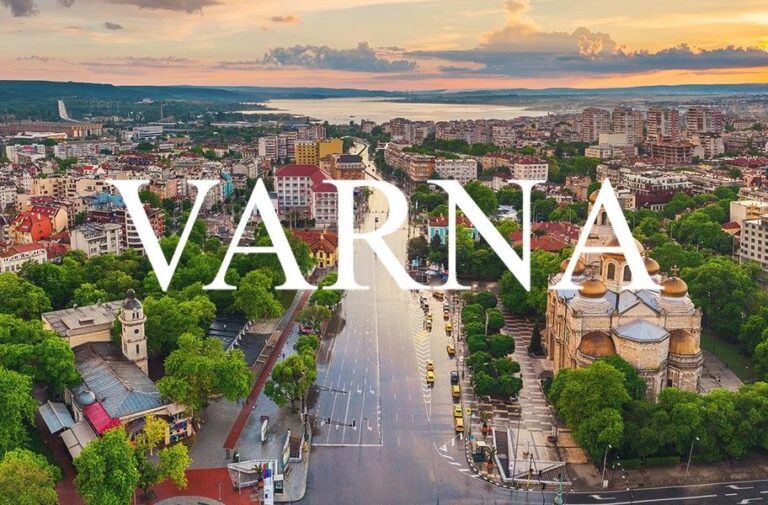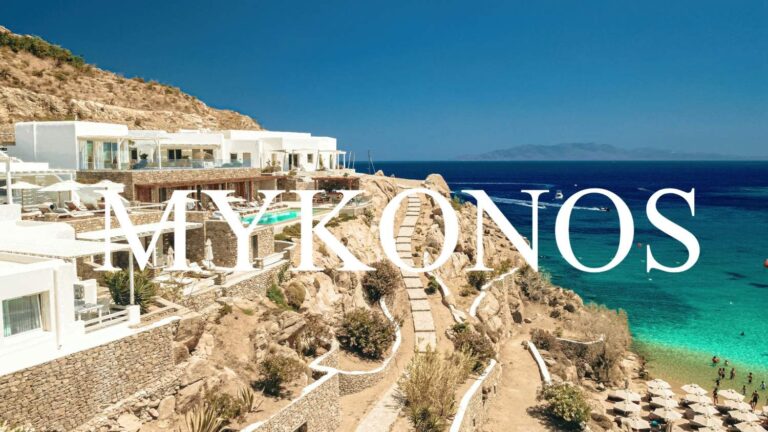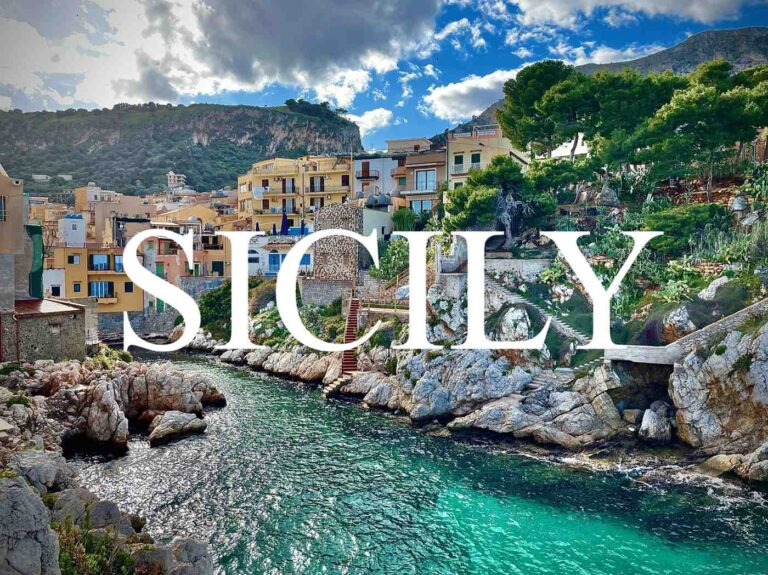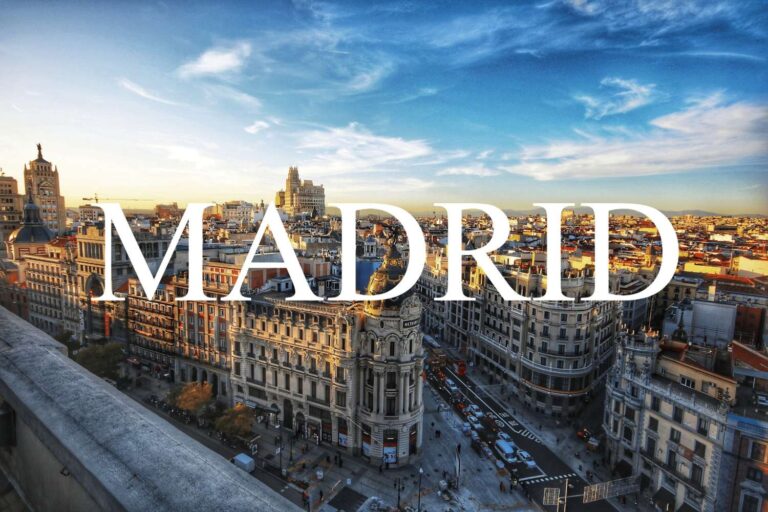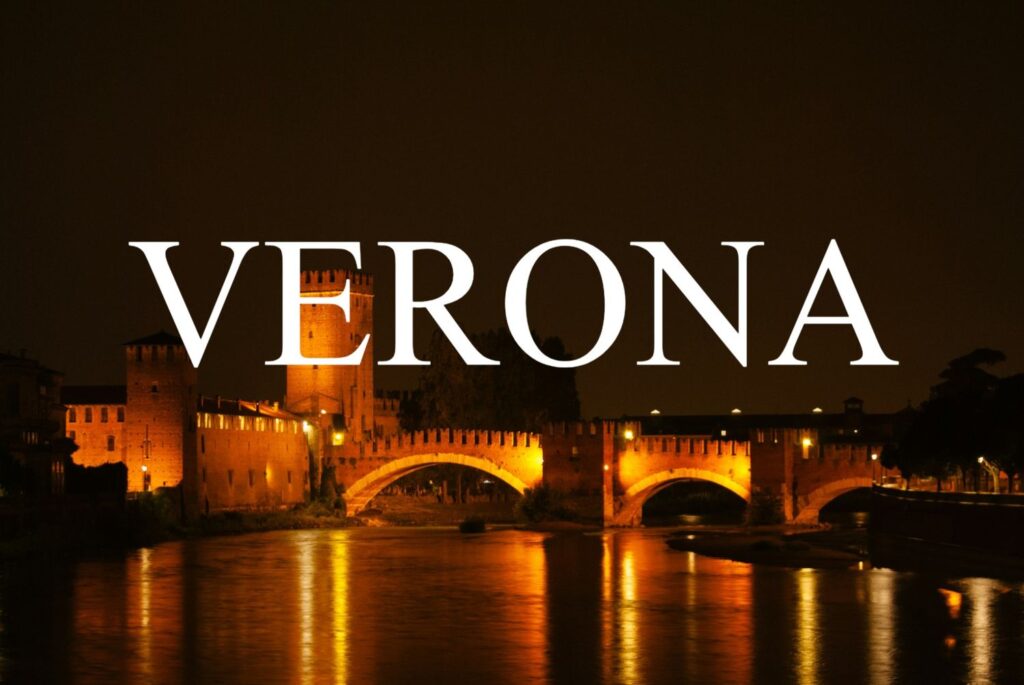
Verona, Italy, renowned worldwide as the romantic backdrop of Shakespeare’s Romeo and Juliet, is a city that effortlessly weaves together history, culture, and timeless charm. Located in the heart of the Veneto region in northern Italy, Verona captivates visitors with its rich Roman heritage, including the magnificent Arena di Verona—an ancient amphitheater still alive with operatic performances today. Wander through enchanting medieval streets lined with quaint shops, elegant piazzas bustling with cafés, and centuries-old churches that tell stories of a bygone era.
Beyond its literary fame, Verona is a vibrant destination for lovers of art, architecture, and Italian gastronomy. Savor traditional Veronese dishes paired with exquisite local wines as you soak in the city’s warm atmosphere. Whether you’re exploring Juliet’s Balcony, admiring frescoes in the Basilica di San Zeno, or simply enjoying a stroll along the Adige River at sunset, Verona promises an unforgettable experience filled with romance and cultural richness.
🗓️ Best Time to Visit Verona
🌸 Spring and Fall (April–June & September–October)
Mild temperatures (15°C–25°C / 59°F–77°F) and fewer tourists make spring and early autumn ideal for sightseeing, wine tasting, and enjoying open-air events.
☀️ Summer (July–August)
Peak season with vibrant festivals and performances at the Arena di Verona, but temperatures can soar to 30°C (86°F) and the city becomes more crowded.
❄️ Winter (November–March)
A quieter, more budget-friendly time to visit. The city lights up with Christmas markets, and you’ll get to explore attractions at a slower pace.
💶 Currency & Travel Essentials
- Currency: Euro (€)
- Language: Italian (English is spoken in most tourist areas)
- Transportation: Buses, taxis, and a walkable historic center; Verona Porta Nuova is the main train station
- Average Daily Budget:
- Budget: €50–€80
- Mid-range: €90–€150
- Luxury: €160+
🏛️ 10 Best Places to Visit in Verona
Verona Arena (Arena di Verona)
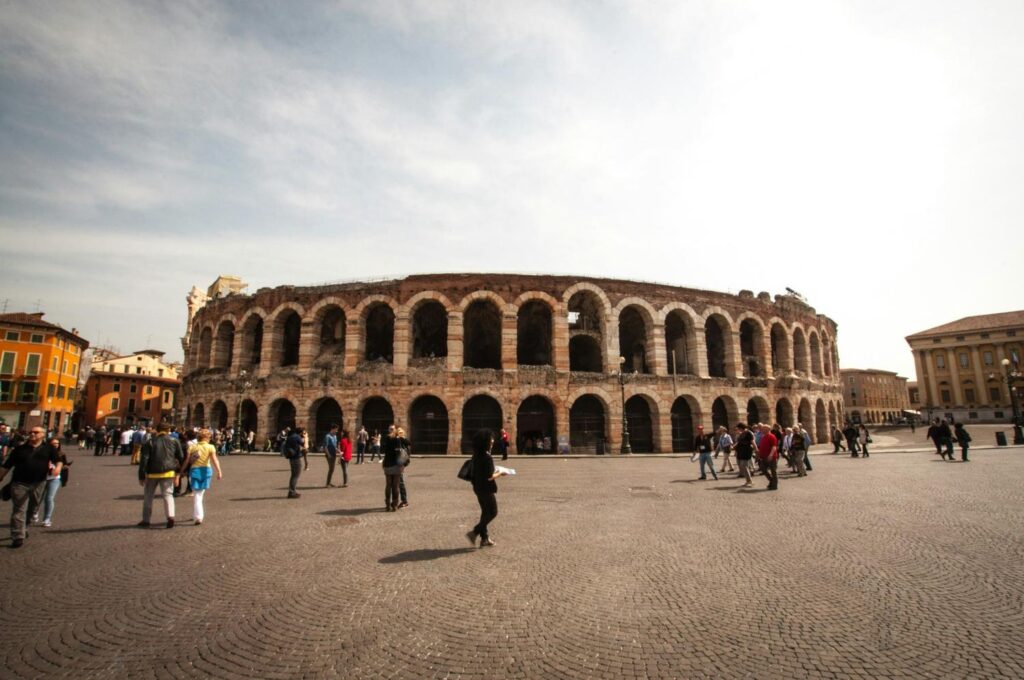
Verona Arena, standing proudly in Piazza Bra, is one of the best-preserved Roman amphitheaters in the world. Built in the 1st century AD, this architectural marvel continues to captivate visitors with its sheer scale, historical significance, and modern-day use as a world-class performance venue.
Whether you’re passionate about ancient history or enchanted by open-air opera under the stars, the Verona Arena offers a magical experience that blends past and present like nowhere else.
🌟 Highlights of Verona Arena
🏰 Remarkable Roman Engineering
• Admire the elliptical structure made of pink-hued Valpolicella marble, originally accommodating over 30,000 spectators.
• Walk through ancient corridors and seating tiers that echo with the footsteps of gladiators and Roman citizens.
🎶 Spectacular Performances
• Attend the famed Arena Opera Festival, held every summer, featuring grand productions in an unforgettable setting.
• Enjoy concerts, ballets, and cultural events year-round, all enhanced by the Arena’s natural acoustics.
📚 Cultural and Historical Value
• Learn about the Arena’s transformation over centuries—from a Roman amphitheater to a medieval fortress and finally a modern stage.
• On-site exhibits and interpretive signs enrich your visit with fascinating historical context.
📍 How to Get There
• Address: Piazza Bra, 37121 Verona, Italy
• By Foot: Centrally placed, it’s within easy walking distance from Verona’s main sights and hotels.
• Public Transport: Numerous buses stop nearby; Verona Porta Nuova train station is about a 15-minute walk.
• By Car: Parking is available at nearby garages, though the area around Piazza Bra is pedestrian-friendly.
🕒 Visitor Information
• Opening Hours: Generally open daily; hours may vary on performance days.
• Admission Fees: Entry fees apply for self-guided visits; separate tickets are required for performances.
• Accessibility: Wheelchair access and assisted seating available—check ahead for arrangements.
💡 Travel Tips
• 🎫 Book performance tickets well in advance, especially for popular operas during summer.
• ☀️ Bring a hat or wear sunscreen if attending daytime events, as seating areas can be exposed.
• 🕰️ Visit during the day for a quiet exploration, then return at night for an unforgettable performance under the stars.
• 📷 Cameras are allowed during non-performance times—perfect for capturing the Arena’s grandeur.
The Verona Arena is more than a monument—it’s a living piece of history that continues to inspire through its timeless beauty and cultural vitality. A visit here connects you directly to the heart of Roman heritage and the soul of Italian artistry.
Juliet’s House (Casa di Giulietta)
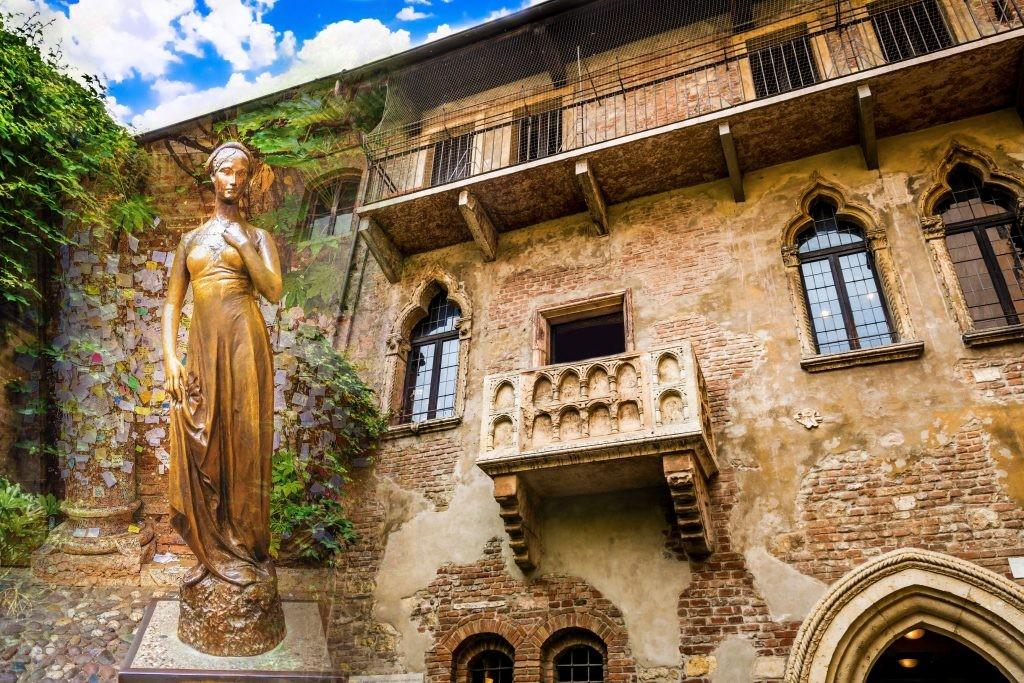
Juliet’s House (Casa di Giulietta) is one of Verona’s most iconic and romantic landmarks. Inspired by Shakespeare’s Romeo and Juliet, this historic 13th-century building draws countless visitors who come to stand beneath the famous balcony, leave love notes, or simply soak in the atmosphere of timeless romance.
Though the connection to the real Juliet is more symbolic than historical, the house offers a charming and memorable experience for literature lovers, couples, and curious travelers.
🌟 Highlights of Juliet’s House
🏛️ The Balcony & Courtyard
• Stand in the courtyard and gaze up at the legendary balcony, the scene of countless romantic reenactments.
• Pose with the bronze statue of Juliet—touching her right breast is believed to bring luck in love.
🏠 Museum Inside the House
• Explore period furnishings, Renaissance art, and love-themed exhibits that capture the spirit of Verona’s literary fame.
• Discover letters to Juliet, written by people around the world seeking advice on matters of the heart.
📜 Literary & Cultural Experience
• Learn about the origins of the Romeo and Juliet story and how Verona became tied to the legend.
• View multimedia displays that bring the tale and its characters to life.
📍 How to Get There
• Address: Via Cappello 23, 37121 Verona, Italy
• By Foot: Easily reached from Piazza delle Erbe and Verona Arena.
• Public Transport: Local buses stop nearby; Verona Porta Nuova station is about a 20-minute walk.
• Parking: Paid parking is available in the city center.
🕒 Visitor Information
• Opening Hours: Usually open daily from 9:00 AM to 7:00 PM (hours may vary seasonally).
• Admission: Entry to the courtyard is free; a ticket is required for the house and museum.
• Accessibility: The courtyard is accessible; the museum has stairs and limited access for wheelchairs.
💡 Travel Tips
• 🎫 Buy tickets online in advance to avoid queues, especially during peak seasons.
• 📷 Take photos early in the morning for the best light and fewer crowds.
• 💌 Consider writing your own letter to Juliet or visiting the Juliet Club nearby.
• 💞 Couples often bring a lock or write names on the love wall—bring a marker if you’d like to join the tradition.
Juliet’s House brings Shakespeare’s legendary tale to life in a setting full of charm and emotion. Whether you’re a romantic at heart or a literary enthusiast, a visit here captures the spirit of Verona—where love, history, and imagination meet.
Piazza delle Erbe

Piazza delle Erbe is one of the most enchanting squares in Italy, pulsing with history, color, and daily life in the center of Verona. Once the site of the Roman forum, it has evolved over centuries into a bustling market square surrounded by stunning architecture, charming cafés, and centuries-old statues and fountains.
Whether you’re sipping an espresso beneath medieval frescoes or browsing market stalls, Piazza delle Erbe offers a rich sensory experience that blends Verona’s past and present in perfect harmony.
🌟 Highlights of Piazza delle Erbe
🏛️ Architectural Splendor
• Admire the diverse mix of buildings surrounding the square, including the Torre dei Lamberti, Casa Mazzanti, and Palazzo della Ragione.
• Marvel at frescoed facades, ornate balconies, and the Baroque Palazzo Maffei, each telling a piece of Verona’s layered history.
⛲ Fountain & Statues
• See the Madonna Verona Fountain, dating back to Roman times, still standing proudly at the square’s center.
• Discover sculptures, ancient columns, and lion symbols that echo Verona’s Venetian past.
🛍️ Markets & Local Life
• Stroll through daily markets selling fresh produce, souvenirs, flowers, and local crafts.
• Enjoy outdoor dining at lively cafés that offer a perfect view of the square’s beauty and rhythm.
📍 How to Get There
• Address: Piazza delle Erbe, 37121 Verona, Italy
• By Foot: Located in the heart of the historic center, just minutes from Juliet’s House and Piazza dei Signori.
• Public Transport: Easily accessible by local buses; nearest stop is Via Mazzini.
• By Car: Parking is available at garages outside the historic core; pedestrian access recommended.
🕒 Visitor Information
• Opening Hours: Open year-round, with markets typically running from early morning to afternoon.
• Admission Fees: Free to visit and explore; charges apply for access to nearby towers or attractions.
• Accessibility: Flat, cobblestone square; generally accessible to all visitors.
💡 Travel Tips
• 📷 Visit early in the morning or at twilight for the best light and fewer crowds.
• ☕ Grab a seat at a café for people-watching and soaking in the lively atmosphere.
• 🏛️ Climb Torre dei Lamberti for panoramic views of the square and city.
• 🛍️ Support local vendors by purchasing handmade crafts or regional delicacies.
Piazza delle Erbe is more than just a square—it’s a vibrant showcase of Verona’s rich history, culture, and everyday charm. Whether you’re exploring its landmarks, shopping at the market, or simply taking in the views, this piazza offers an unforgettable slice of Italian life.
Castelvecchio & Castelvecchio Bridge
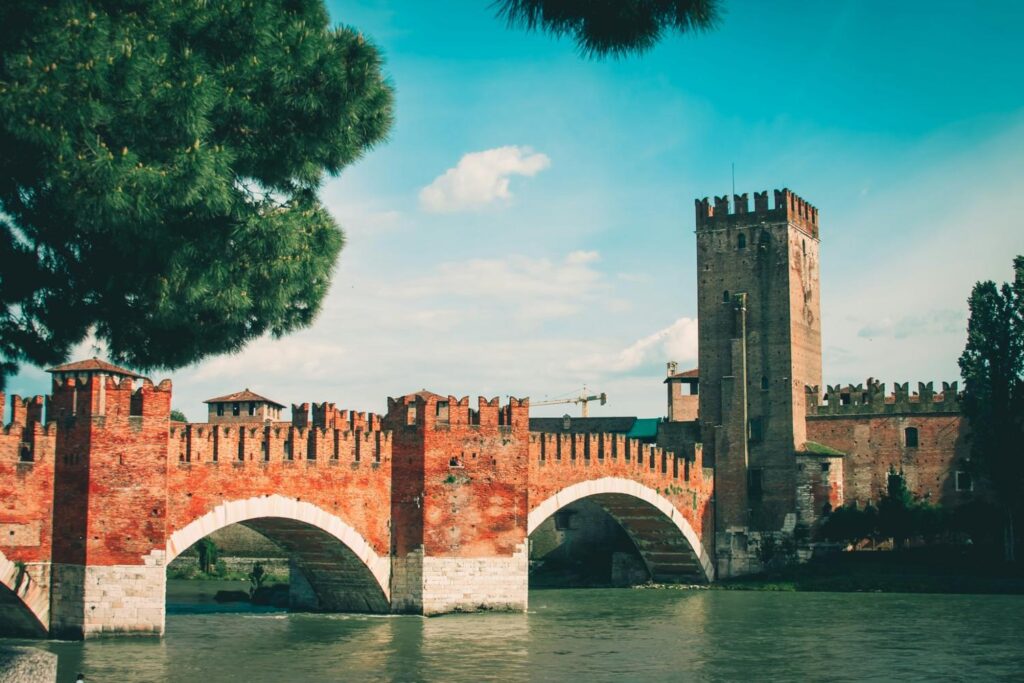
Photo by Raimond Klavins on Unsplash
Castelvecchio and its iconic bridge form one of Verona’s most striking medieval landmarks. Built in the 14th century by the powerful Scaligeri family, this impressive red-brick fortress was designed for both defense and prestige. Today, it houses the Castelvecchio Museum, showcasing an outstanding collection of art, sculpture, and weaponry, while the bridge—Ponte Scaligero—offers breathtaking views over the Adige River.
This historic site blends architectural grandeur, military history, and artistic heritage, making it a must-visit destination in Verona.
🌟 Highlights of Castelvecchio & Castelvecchio Bridge
🏯 Historic Fortress & Architecture
• Walk through the imposing castle walls, towers, and crenellated battlements that once protected Verona.
• Admire the strategic design of the fortress, built to guard against both invaders and political rivals.
🖼️ Castelvecchio Museum
• Explore works by Italian masters like Pisanello, Mantegna, and Bellini in beautifully restored halls.
• See medieval armor, sculptures, religious art, and city relics curated by architect Carlo Scarpa.
🌉 Scenic Ponte Scaligero (Scaliger Bridge)
• Cross the fortified bridge with its dramatic arches and towered gateways.
• Enjoy panoramic views of the Adige River and the Verona skyline, especially magical at sunset.
📍 How to Get There
• Address: Corso Castelvecchio, 2, 37121 Verona VR, Italy
• By Foot: About 10–15 minutes from Piazza Bra and the Verona Arena.
• Public Transport: Bus routes stop nearby; Verona Porta Nuova train station is also within walking distance.
• Parking: Public parking lots available close to the city center.
🕒 Visitor Information
• Opening Hours: Usually open Tuesday to Sunday, from 10:00 AM to 6:00 PM (closed Mondays).
• Admission: Entry fees apply for the museum; discounts for students, seniors, and families. Bridge access is free.
• Accessibility: Main areas of the museum are accessible, but some upper floors and ramparts may not be.
💡 Travel Tips
• 🎫 Book museum tickets in advance, especially during high season.
• 📷 Don’t miss the photo opportunity from the bridge at golden hour.
• 🧭 Set aside time to explore both the museum and the full bridge walk—it’s worth it.
• 📖 Learn a bit about the Scaliger family before visiting to better appreciate the history.
Castelvecchio and its majestic bridge bring Verona’s medieval past to life in an unforgettable way. Whether you’re an art lover, a history enthusiast, or simply enjoy stunning river views, this site promises a richly rewarding experience in the heart of the city.
Piazza dei Signori
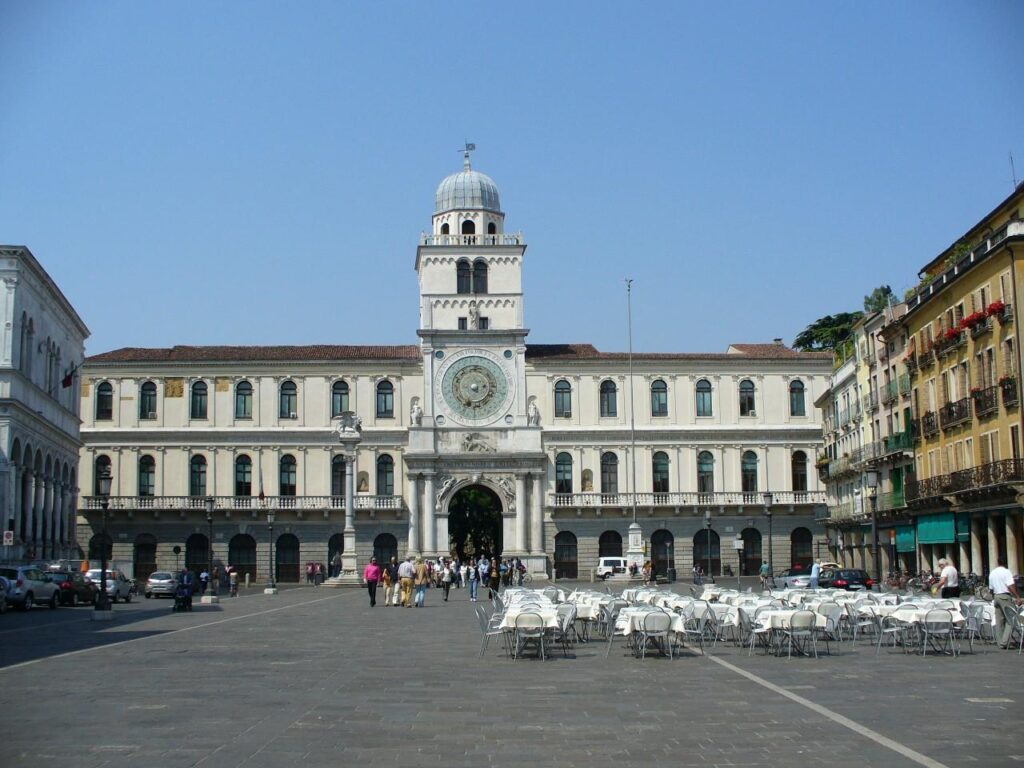
Piazza dei Signori is a beautifully preserved square that reflects the grandeur and governance of medieval Verona. Also known as Piazza Dante, it has long been the city’s political and cultural heart, framed by stately palaces and crowned by a monument to Dante Alighieri, who once found refuge in the city.
Walking through this square feels like stepping into a history book—one where art, literature, and civic pride meet in elegant harmony.
🌟 Highlights of Piazza dei Signori
🏰 Architectural Landmarks
• Surrounded by historic buildings such as Palazzo della Ragione, Palazzo del Capitano, and the Loggia del Consiglio—a masterpiece of Renaissance architecture.
• Gaze at the harmonious blend of medieval and Renaissance styles that once hosted Verona’s ruling elite.
🗿 Dante Alighieri Statue
• At the center stands the iconic statue of Dante, the exiled poet who found a second home in Verona.
• A beloved photo spot and a tribute to Verona’s rich literary ties.
🎭 Cultural Events
• The square frequently hosts festivals, concerts, and open-air performances, bringing modern vibrancy to this ancient civic space.
• Seasonal illuminations and public gatherings keep the square lively and culturally engaging year-round.
📍 How to Get There
• Address: Piazza dei Signori, 37121 Verona, Italy
• By Foot: Just steps from Piazza delle Erbe and Juliet’s House, making it ideal for walking tours.
• Public Transport: Well-served by buses with nearby stops on Via Mazzini and Corso Porta Borsari.
• By Car: Park in city garages and enjoy a scenic walk into the historic center.
🕒 Visitor Information
• Opening Hours: Open 24/7; surrounding buildings may have varied visiting times.
• Admission Fees: The square itself is free to explore; guided tours or museum entries nearby may have a cost.
• Accessibility: Flat and pedestrian-friendly, with ramps and pathways for wheelchairs and strollers.
💡 Travel Tips
• 📷 Visit in the early evening for golden light and a tranquil atmosphere.
• 📚 Join a walking tour to learn about the square’s political and poetic past.
• 🕰️ Pair your visit with nearby attractions like the Scaliger Tombs or Torre dei Lamberti.
• 🍦 Stop at a nearby gelateria and enjoy the view from a shaded bench.
Piazza dei Signori offers a quieter, more refined charm than Verona’s bustling piazzas, making it a perfect place to reflect on the city’s intellectual and political history. It’s where power once ruled and poetry still lingers in the air—a timeless stop for every Verona traveler.
Torre dei Lamberti
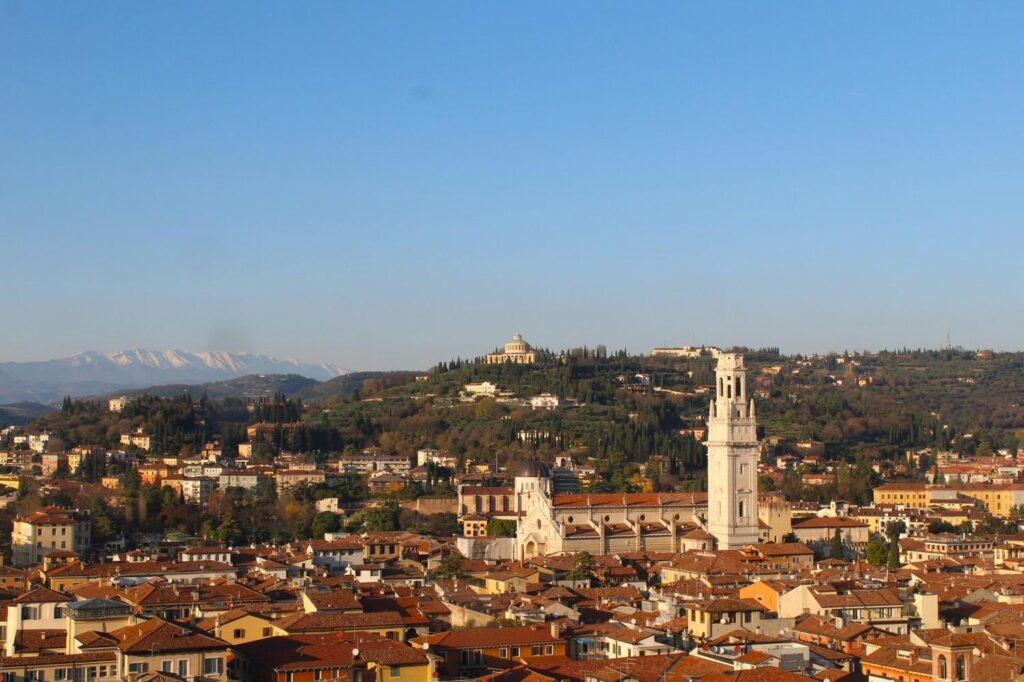
Photo by Rui Alves on Unsplash
Torre dei Lamberti is a striking symbol of Verona’s rich history, offering both breathtaking views and a deep dive into the city’s medieval past. Rising high above the historic center, this 84-meter tower stands as one of Verona’s most iconic landmarks. The tower’s blend of architectural elegance and historical significance makes it an unmissable spot for visitors. Whether you’re a history buff, a photography enthusiast, or someone simply seeking panoramic views, Torre dei Lamberti is a must-visit.
🌟 Highlights of Torre dei Lamberti
🗼 Majestic Architecture
- Medieval Tower: The tower’s origins date back to the 12th century, and it was part of the Lamberti family’s grand palazzo. Its Romanesque design is complemented by Gothic elements, creating an impressive silhouette against the Verona skyline.
- Bell Tower: The tower houses a series of bells, including the famous Marangona, which still rings across the city today.
📸 Breathtaking Views
- Panoramic Experience: After climbing 368 steps (or taking the elevator for a quicker ascent), visitors are rewarded with a 360-degree view of Verona’s old town, with the Adige River winding through the landscape and the distant Alps framing the horizon.
- Photo Opportunities: The view from the top of Torre dei Lamberti is a photographer’s dream, offering stunning perspectives of Verona’s medieval rooftops, piazzas, and landmarks, including the Arena di Verona and Castel San Pietro.
🔔 Historical Significance
- Medieval Timekeeping: The tower was originally constructed to showcase the power of the Lamberti family and to serve as an important timekeeping and signaling point for the people of Verona.
- Cultural Heritage: The tower has played a key role in the city’s identity, with its bells used to mark important civic events, celebrations, and even warnings.
🎨 Artistic Beauty
- Ancient Frescoes: The interior of the tower contains some fascinating frescoes, offering insight into medieval Verona’s artistry.
- Exhibitions: Temporary exhibitions and displays are often held in the lower floors, adding a cultural layer to the experience.
📍 How to Get There
- Address: Torre dei Lamberti, Piazza dei Signori, 37121 Verona, Italy
- By Foot: Located right in the heart of Verona, it’s a short walk from the Piazza dei Signori and Piazza delle Erbe. A perfect stop as part of a walking tour.
- Public Transport: The tower is easily accessible by public transport, with bus stops nearby at Corso Porta Borsari.
- By Car: Park in the historic city center garages and stroll to the tower. The area is pedestrian-friendly, so it’s best to explore on foot.
🕒 Visitor Information
- Opening Hours:
- Summer: 10:00 AM – 8:00 PM
- Winter: 10:00 AM – 6:00 PM
- Accessibility:
- The first few floors are accessible by elevator, but the final leg to the top requires a climb up the 368 steps. It’s a great option for those looking for a bit of a physical challenge or for a leisurely panoramic experience.
💡 Travel Tips
- 📷 Golden Hour Views: If you want to catch the best views and light for your photos, try visiting early in the morning or in the late afternoon. The sun’s golden glow bathes the city in magic.
- 🏃♂️ Climbing the Steps: If you’re up for it, take the stairs instead of the lift! It’s a bit of a workout, but the experience of ascending this historic tower is truly rewarding.
- 🍕 Grab a Bite Nearby: After exploring the tower, head to a nearby trattoria or café and indulge in Verona’s delicious local cuisine, like risotto all’Amarone or a slice of veronese pandoro.
- 🎨 Pair it with Art & History: Combine your visit with a stop at the nearby Museo di Castelvecchio or the Arena di Verona for a deeper understanding of the city’s rich cultural heritage.
Torre dei Lamberti stands as a proud reminder of Verona’s medieval past and offers unparalleled views of this beautiful city. Whether you’re looking for a place to reflect on Verona’s historical significance or simply searching for that perfect panoramic shot, this tower provides the perfect vantage point. Don’t miss out on this quintessential experience—the climb, the views, and the history are all worth it!
Basilica of San Zeno Maggiore
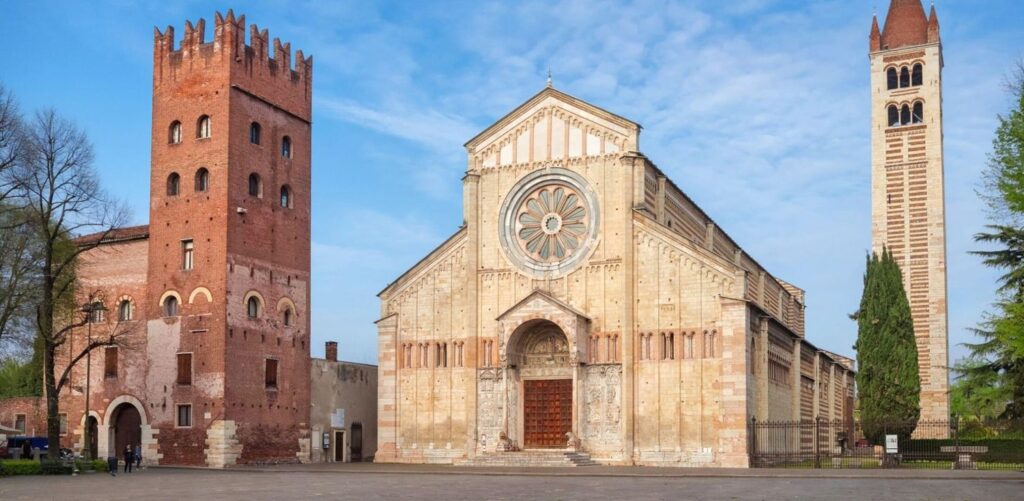
The Basilica of San Zeno Maggiore is one of Verona’s most cherished religious and architectural treasures. Renowned for its stunning Romanesque design, peaceful atmosphere, and artistic richness, this 12th-century church is a quiet yet powerful symbol of Verona’s spiritual and cultural heritage.
Often overshadowed by the city’s more famous attractions, San Zeno offers a more intimate and contemplative experience, making it a favorite for both architecture lovers and those seeking a meaningful moment away from the crowds.
🌟 Highlights of the Basilica of San Zeno
🏛️ Romanesque Architecture
• Admire the warm-hued stone façade, bronze door panels, and rose window known as the “Wheel of Fortune.”
• Walk through the tranquil interior, featuring striped stone columns, vaulted ceilings, and elegant symmetry.
🎨 Artistic Treasures
• See Andrea Mantegna’s masterpiece, the altarpiece of San Zeno, a highlight of Renaissance painting.
• Explore the crypt and upper church, both preserving sacred relics and medieval frescoes.
💒 Spiritual Significance
• The basilica is dedicated to San Zeno, Verona’s patron saint, whose tomb lies in the atmospheric crypt.
• It’s also linked to the wedding scene in Shakespeare’s Romeo and Juliet, adding a touch of literary legend.
📍 How to Get There
• Address: Piazza San Zeno, 2, 37123 Verona VR, Italy
• By Foot: Around 20 minutes from the historic center; a scenic walk past ancient city walls.
• Public Transport: Buses run from Porta Nuova and Piazza Bra directly to San Zeno.
• By Car: Limited parking available nearby; street or public garage parking recommended.
🕒 Visitor Information
• Opening Hours: Typically open daily; closed during certain religious services.
• Admission Fees: Small entry fee, with discounts for students, seniors, and groups.
• Accessibility: Mostly accessible; contact ahead for specific assistance if needed.
💡 Travel Tips
• 📷 Bring a camera—photography is usually allowed without flash.
• 🧘♂️ Take time to sit and soak in the peaceful surroundings—it’s a great place for quiet reflection.
• 📖 Consider reading a brief history before visiting to fully appreciate the symbolism in the art and architecture.
• 🕰️ Visit early or late in the day for a serene atmosphere with fewer visitors.
The Basilica of San Zeno Maggiore is more than just a church—it’s a place where history, art, faith, and legend come together in perfect harmony. Whether you’re drawn by its architecture, its sacred art, or its Shakespearean ties, a visit here will leave a lasting impression of Verona’s timeless soul.
Giardino Giusti
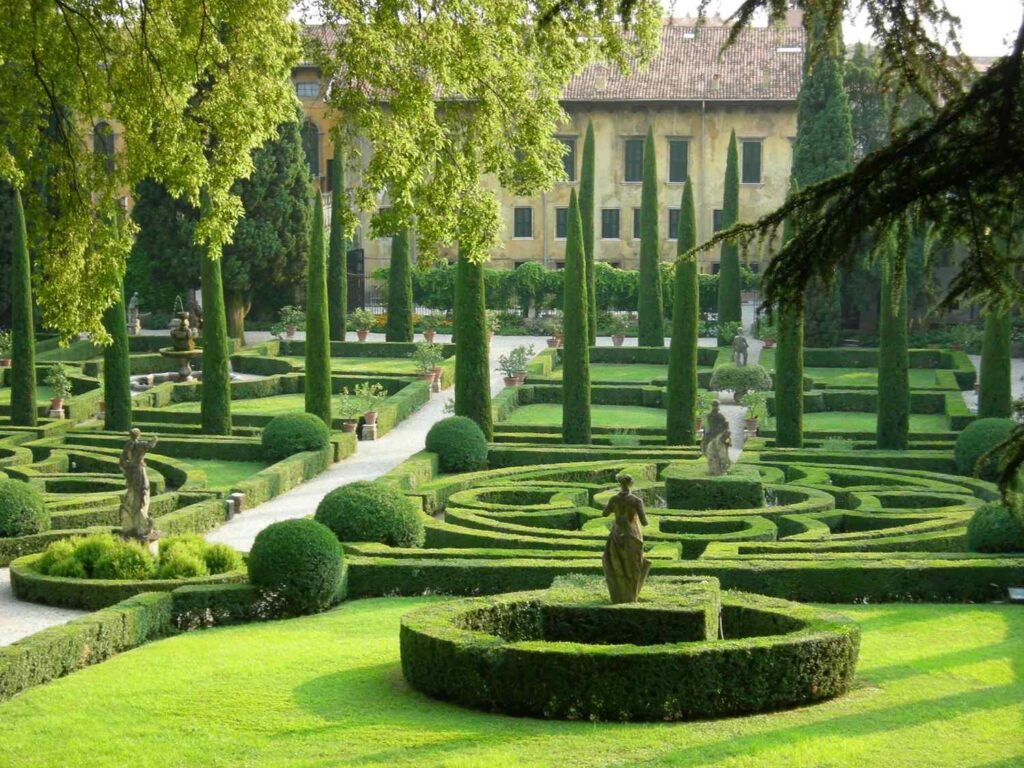
Tucked away in the heart of Verona, Giardino Giusti is one of Italy’s most beautifully preserved Renaissance gardens. A true oasis of tranquility, it offers visitors a serene escape into nature while providing a glimpse into the opulence of the past. As you stroll through the meticulously manicured grounds, you’ll find yourself transported to a time of aristocratic luxury, where art, nature, and culture harmoniously intersect.
Dating back to the late 1500s, the Giusti Garden is an excellent example of Italian Renaissance garden design, blending natural beauty with classical architecture and sculptural art. This enchanting garden is not only a place of relaxation but also a space steeped in history, offering a peaceful retreat right within the city.
🌟 Highlights of Giardino Giusti
🌳 Stunning Landscaping
- Renaissance Design: The garden is a perfect representation of Renaissance ideals, with symmetrical paths, terraced levels, and a central axis leading the eye toward the stunning backdrop of the city.
- Floral Beauty: In the spring and summer, the garden bursts into vibrant colors, with carefully arranged flower beds, cypress trees, and neatly trimmed hedges that create a visual feast for the senses.
- Lush Greenery: The garden’s natural features include a wide variety of plants, from evergreen shrubs to seasonal blossoms, offering year-round beauty.
🗺️ Panoramic Views
- Terraces Overlooking Verona: From the upper terraces of the garden, you’ll be treated to a stunning panoramic view of Verona, with the Adige River winding through the city below and the rolling hills in the distance.
- Ideal Photo Spots: The elevated views and the garden’s beautiful layout offer some of the best photo opportunities in Verona, especially at sunset when the golden light casts a warm glow over the entire space.
🎭 Historical Charm
- Frescoed Palaces: The garden is attached to the Palazzo Giusti, a grand villa that also houses remarkable frescoes. The entire complex is a living example of Renaissance aesthetics.
- Famous Labyrinth: A walk through the garden wouldn’t be complete without exploring its famous labyrinth of cypress trees, which represents the human search for knowledge and enlightenment. It’s fun, a bit challenging, and an intriguing way to engage with the garden’s thematic elements.
- Classical Statues & Sculptures: Throughout the garden, you’ll find classical statues and fountains that add a sculptural elegance to the space. These serve as decorative focal points and reflect the intellectual sophistication of the period.
💧 Water Features
- Reflecting Pools and Fountains: Elegant fountains and still water features add to the serene atmosphere of the garden, creating a calming, meditative space. These water elements are beautifully integrated into the overall layout of the garden, symbolizing the connection between nature and art.
📍 How to Get There
- Address: Giardino Giusti, Via Giardino Giusti, 37129 Verona, Italy
- By Foot: Located within walking distance of Verona’s historic center, it’s a short 10-minute walk from Piazza delle Erbe. Perfect for a quiet escape from the hustle and bustle of the city.
- Public Transport: The garden is accessible by bus from Verona’s main stations. The closest bus stop is Piazza Isolo, just a few minutes’ walk away.
- By Car: There are parking spaces near the garden, and if you’re driving, the location is easily reachable from the city center.
🕒 Visitor Information
- Opening Hours:
- March to October: 9:00 AM – 7:00 PM
- November to February: 9:00 AM – 5:00 PM
- Accessibility: The garden is mostly accessible to visitors with limited mobility, although the steep terraced areas may require some effort to navigate.
💡 Travel Tips
- 🌿 Best Time to Visit: Visit during spring or early summer to enjoy the lush greenery and vibrant flowers. Autumn also offers a beautiful color palette, with golden leaves adding a charming touch to the garden’s design.
- 📷 Photography Tips: Don’t forget to bring your camera! The garden is a photographer’s paradise with its classical elements, intricate details, and scenic viewpoints. Golden hour offers the best lighting for those perfect shots.
- 🍽️ Nearby Dining: After your garden visit, head to a nearby café or restaurant for a traditional Veronese meal. Try bigoli with duck or indulge in a plate of risotto all’Amarone paired with a local wine.
- 🧑🤝🧑 Guided Tours: Consider booking a guided tour to learn about the rich history of the Giusti family, the garden’s design principles, and its place in the city’s cultural heritage.
Giardino Giusti offers a peaceful escape from the more tourist-heavy spots of Verona, immersing you in beauty, history, and nature. Whether you’re looking to enjoy a quiet moment among centuries-old trees, take in the stunning views of the city, or explore the intricate symbolism of its Renaissance design, this garden is a perfect retreat. A visit to Giardino Giusti is like stepping into a serene, verdant world where time seems to slow down—a must-see destination for anyone exploring Verona.
Scaliger Tombs (Arche Scaligere)
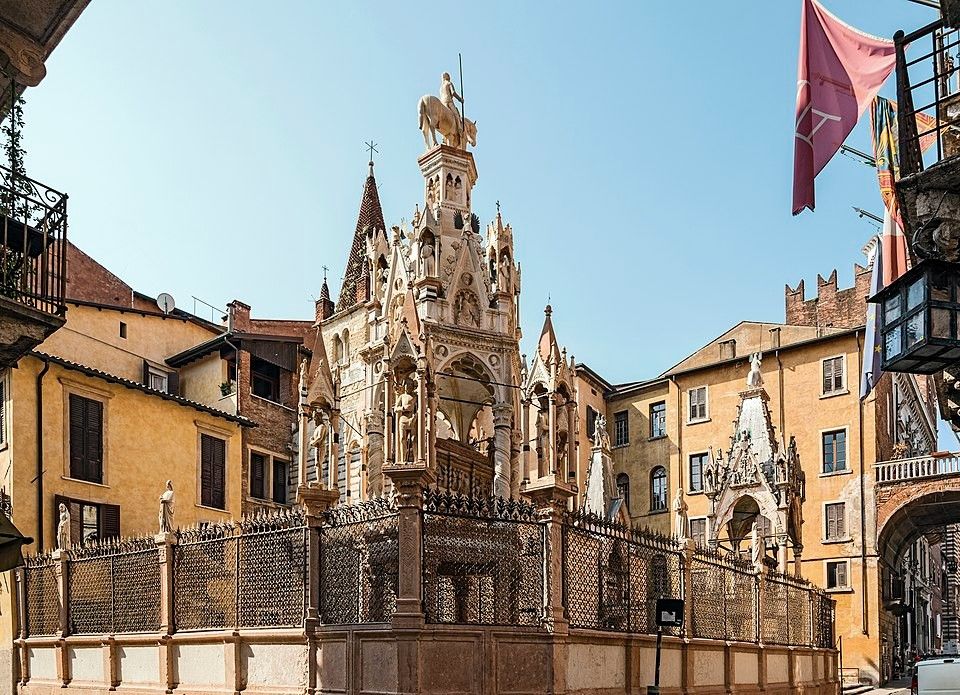
The Scaliger Tombs, known as Arche Scaligere, are an extraordinary example of Gothic funerary art, dedicated to the powerful Scaligeri family who once ruled Verona. Set beside the Church of Santa Maria Antica, these elaborately carved monuments tell the story of a dynasty that shaped the city’s medieval identity.
Guarded by wrought-iron gates and topped with knightly statues, the tombs are as dramatic in design as the history they represent—making this site a must-see for fans of Gothic architecture, medieval history, and hidden gems.
🌟 Highlights of the Scaliger Tombs
🏛️ Gothic Architecture
• Admire the intricate canopies, pointed arches, and sculpted spires that rise above each tomb.
• The tombs of five Scaligeri lords, including the famed Cangrande I della Scala, are housed here in elevated sarcophagi that reflect their noble status.
⚔️ Historical Legacy
• Learn about the Scaligeri family, who ruled Verona during the 13th and 14th centuries and played a key role in shaping the city’s political and cultural life.
• Cangrande I, a patron of Dante Alighieri, is depicted as a mounted knight—one of the square’s most iconic images.
🎨 Artistic Detail
• Note the use of symbolism and heraldry on the tombs, from the family’s ladder emblem (scala) to religious motifs.
• A fine example of funerary sculpture as storytelling, each tomb offers visual insight into the era’s values and beliefs.
📍 How to Get There
• Address: Via Santa Maria Antica, 37121 Verona VR, Italy
• By Foot: Just steps from Piazza dei Signori and Juliet’s House—easy to include in a walking tour.
• Public Transport: Accessible via local bus lines with stops throughout the historic center.
• By Car: Park outside the old town and enjoy a scenic stroll through the city’s medieval streets.
🕒 Visitor Information
• Opening Hours: Open daily from spring through fall; check seasonal times in advance.
• Admission Fees: Small fee to enter the gated area; views are still impressive from the outside if closed.
• Accessibility: The site is viewable from the street, though interior access may be limited for wheelchair users.
💡 Travel Tips
• 📚 Read up on the Scaligeri before your visit—it enriches the experience.
• 📷 Ideal for architectural photography and close-ups of Gothic details.
• 🗺️ Combine your visit with nearby landmarks like Piazza dei Signori, Torre dei Lamberti, or the Church of Sant’Anastasia.
• 🔕 Respect the solemn nature of the site—these are actual tombs of historical figures.
The Scaliger Tombs offer a striking glimpse into Verona’s medieval past and the legacy of one of its most influential families. Rich in symbolism, history, and artistic brilliance, this site provides a quiet yet profound reminder of the city’s Gothic splendor.
Adige River Walks
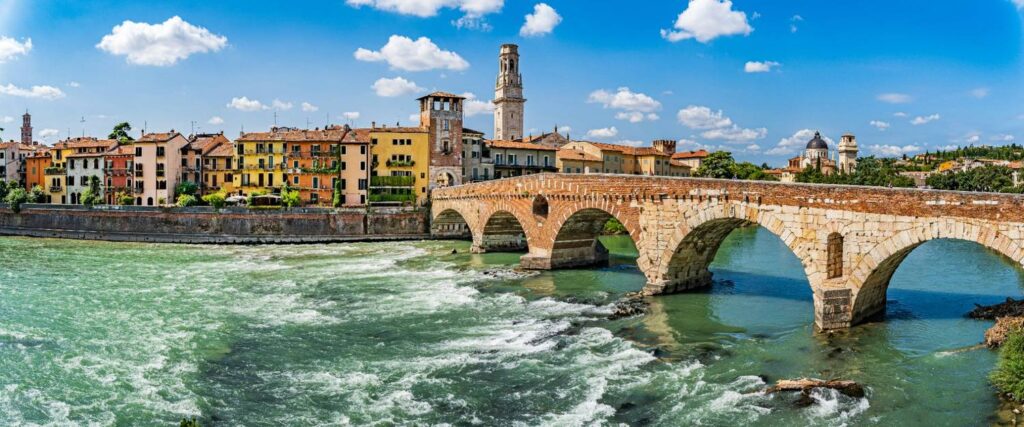
Photo by Patrick Pahlke on Unsplash
The Adige River is not only the geographical heart of Verona, but it also holds a special place in the city’s history, culture, and daily life. The river winds through the city, offering serene views and a peaceful atmosphere perfect for a leisurely stroll. Whether you’re looking for a quiet walk by the water, picturesque photo opportunities, or a deeper connection with the city’s past, the Adige River Walks offer a unique and calming experience that showcases Verona’s natural beauty.
As you walk along the riverbanks, you’ll be treated to some of Verona’s most iconic landmarks and hidden gems. The sound of gently flowing water, the stunning bridges, and the views of the city’s historical architecture create a backdrop that feels both timeless and fresh. Whether you’re a local or a visitor, the Adige River Walk is a perfect way to experience Verona from a new perspective.
🌟 Highlights of Adige River Walks
🌉 Historic Bridges and Architecture
- Ponte Pietra: One of Verona’s most famous landmarks, this ancient Roman bridge spans the Adige River and offers stunning views of both the city and the river itself. Whether you’re walking across or gazing at it from the bank, it’s a great spot for photos.
- Ponte Scaligero: Another iconic bridge, this medieval gem leads to Castelvecchio, offering sweeping views of the river and surrounding area. The bridge’s impressive arches and stonework make it a must-see stop on your walk.
- Riverside Palaces and Villas: As you walk along the Adige, you’ll pass beautiful historical buildings that line the river, many of which date back to Verona’s rich medieval and Renaissance periods.
🌳 Natural Beauty
- Tree-Lined Paths: The banks of the Adige are adorned with lush greenery, trees, and well-maintained pathways, making for a peaceful, shady escape even on hot summer days.
- Park Areas: Along the river, there are various green spaces where you can sit and relax, with lovely views of the river and Verona’s skyline. These parks are perfect for a picnic, a quiet read, or simply soaking in the scenery.
- Wildlife Spotting: The riverbanks are home to various bird species, making it a great place for nature enthusiasts to spot local wildlife, especially in the early mornings or late afternoons.
🖼️ Scenic Views
- Verona’s Skyline: From many points along the river, you can enjoy sweeping views of Verona’s charming rooftops, medieval towers, and the distant hills that surround the city.
- Sunset Views: The Adige River offers some of the best sunset views in Verona. As the sun dips behind the hills, the river reflects the warm hues of the sky, creating a romantic and peaceful atmosphere.
🎭 Cultural and Historical Significance
- Roman and Medieval History: The river played a vital role in the city’s development, serving as both a trade route and a natural barrier. Walking along its banks, you’ll feel a deeper connection to the past and the events that shaped Verona’s identity.
- Festivals and Events: During the warmer months, the riverbanks come alive with cultural events, including music festivals, outdoor performances, and seasonal markets. Walking along the Adige during these times adds an extra layer of excitement and vibrancy to the experience.
📍 How to Get There
- Address: The Adige River flows throughout Verona, so you can access it from various points around the city. Some popular starting points for river walks include:
- Ponte Pietra (on the eastern side of the river)
- Ponte Scaligero (near Castelvecchio, on the western side)
- Piazza Bra (at the southern tip near the Arena)
- By Foot: The river is easily accessible by foot from the city’s historic center, making it ideal for a relaxing stroll during a day of sightseeing.
- Public Transport: There are bus stops and stations near several key river crossings, including those at Piazza Isolo and Corso Porta Nuova.
🕒 Visitor Information
- Opening Hours: The Adige River Walks are open year-round, 24/7. The paths along the river are public and accessible at all hours.
- Admission Fees: Free! The Adige River Walks are open to all, with no admission fees required.
- Accessibility: The pathways are mostly flat and accessible to people with mobility issues, although some areas near the bridges may have uneven terrain.
💡 Travel Tips
- 🏃♂️ Early Morning or Evening Walks: For a peaceful experience, try to visit early in the morning or in the evening. These times offer the best light for photography and fewer crowds, allowing you to truly appreciate the tranquility of the river.
- 📷 Perfect Photo Ops: Don’t forget your camera! The bridges, especially Ponte Pietra and Ponte Scaligero, offer perfect spots for taking photos, whether you’re capturing the riverside reflections or the panoramic cityscape.
- 🌳 Relax and Unwind: Bring a book or a picnic blanket and enjoy a leisurely afternoon by the river. The parks and shaded areas make for a perfect spot to relax.
- 🏙️ Pair with Nearby Attractions: The river walk is conveniently located near other major Verona attractions like the Arena di Verona, Piazza delle Erbe, and Castelvecchio. You can easily combine a walk along the Adige with a visit to the city’s historical landmarks.
The Adige River Walks offer a unique, calming way to experience Verona from a different angle. With its historic bridges, picturesque views, and peaceful atmosphere, a walk along the river is the perfect way to slow down and appreciate the natural beauty and cultural richness of this remarkable city. Whether you’re looking to reflect, explore, or simply take in the sights and sounds of Verona, the Adige River provides a serene backdrop for all.
📍 How to Get to Verona
- By Air: Verona Villafranca Airport (VRN) is about 10 km from the city center, with bus and taxi access.
- By Train: High-speed trains connect Verona with Venice, Milan, Florence, and Rome.
- By Car: Verona is easily accessible by motorway; parking is available near the historic center.
🕒 Visitor Information
- Most museums and landmarks are open from 10:00 AM to 6:00 PM (check seasonal hours).
- Verona Card is available for 24 or 48 hours, offering free or discounted entry to major attractions and free city bus rides.
💡 Travel Tips
- 📅 Book Arena di Verona tickets early if visiting during the opera season (June–September).
- 🍷 Try local specialties like Amarone wine, risotto all’Amarone, and pandoro, especially in winter.
- 👟 Wear comfortable shoes—the city is best explored on foot over cobblestone streets.
- 📸 Visit Juliet’s House early in the morning to avoid crowds and take photos in peace.
- 💌 Leave a love note on Juliet’s Wall or write a letter (just like in the film Letters to Juliet).
📝 Additional Information
- Safety: Verona is a safe city with friendly locals and well-maintained public spaces.
- Wi-Fi: Available in most public areas, hotels, and cafes.
- Shopping: Explore Via Mazzini for high-end boutiques and local shops selling handmade leather goods, crafts, and souvenirs.
- Festivals: Look out for Vinitaly (wine expo in April), Verona in Love (February), and the annual Christmas Market in Piazza dei Signori.
- Day Trips: Easily accessible destinations include Lake Garda, Venice, and the Valpolicella wine region.
🌍 Final Thoughts
Verona is a city that speaks to the soul—romantic, walkable, and rich in history. Whether you’re climbing ancient towers, watching opera under the stars, or sipping a glass of Amarone by the river, every moment in Verona feels like a page from a classic love story. Make time for this Italian gem—you might just fall in love.

I’m Shreyash Mhashilkar — a full-stack developer by profession, and a passionate explorer of the future at heart.
With a strong foundation in both front-end and back-end , I spend my days building websites and applications that are not just functional, but scalable, intuitive, and user-focused.

